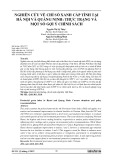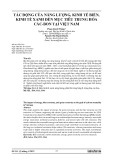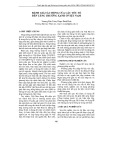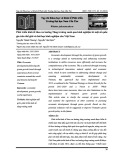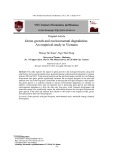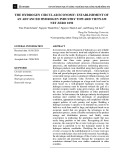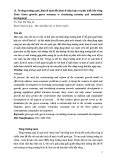
VNU Journal of Economics and Business, Vol. 4, No. 6 (2024) 73-82
73
Original Article
Research on consumer awareness and attitudes
towards green financial products in Vietnam
To Minh Huong*
Thuyloi University
No. 175, Tay Son Street, Dong Da District, Hanoi, Vietnam
Received: October 09, 2024
Revised: December 06, 2024; Accepted: December 25, 2024
Abstract: This study explores Vietnamese consumers’ perceptions and attitudes towards green
financial products, including green bonds, green investment funds, and green insurance. Utilizing a
mixed-method approach, the research combines quantitative surveys and qualitative in-depth
interviews to assess the awareness, attitudes, and willingness of Vietnamese consumers to engage
with these eco-friendly financial options. The findings indicate a varying level of awareness and a
generally positive attitude towards green financial products, albeit with some reservations regarding
their perceived risks and benefits. The study concludes with recommendations for enhancing
consumer education and promoting the adoption of green financial products, thereby supporting
sustainable economic growth in Vietnam.
Keywords: Green financial products, perception, attitude, Vietnamese consumer.
1. Introduction *
In recent years, the global financial market
has increasingly focused on sustainability,
leading to the growth of green financial
products, which offer financial returns while
promoting environmental sustainability. These
products encompass green bonds, green
investment funds, and green insurance, all aimed
at financing projects that mitigate environmental
risks and foster sustainable development (Bauer
& Hann, 2014). In Vietnam, in a rapidly
developing economy facing significant
________
* Corresponding author
E-mail address: huongtm@tlu.edu.vn
https://doi.org/10.57110/vnu-jeb.v4i6.355
Copyright © 2024 The author(s)
Licensing: This article is published under a CC BY-NC
4.0 license.
environmental challenges, the adoption and
promotion of green financial products are seen
as vital to achieving long-term sustainable
development goals (Tran, 2020).
The concept of green finance is relatively
new in Vietnam, where traditional financial
instruments have long dominated the market.
However, growing recognition of environmental
issues has highlighted the need to align
economic growth with environmental
sustainability. For example, green bonds finance
projects such as renewable energy and energy-
efficient buildings (Nguyen, 2023), while green
Copyright © 2024 The author(s)
Licensing: This article is published under a CC BY-NC
4.0 license.
VNU Journal of Economics and Business
Journal homepage: https://jeb.ueb.edu.vn

T.M. Huong / VNU Journal of Economics and Business, Vol. 4, No. 6 (2024) 73-82
74
investment funds enable investors to support
sustainable development initiatives. Similarly,
green insurance products provide coverage for
environmental risks, promoting responsible
behaviors by offering lower premiums for eco-
friendly practices (Nguyen et al., 2023).
Despite the global focus on sustainable
finance, awareness and adoption of green
financial products among Vietnamese
consumers remain limited. This study aims to
explore the perceptions and attitudes of
Vietnamese consumers towards green financial
products, focusing on their awareness, perceived
benefits, and willingness to adopt these products.
Understanding these factors is crucial for
financial institutions and policymakers to
develop strategies that promote green financial
product adoption, contributing to Vietnam’s
sustainable economic development (Zhuang et
al., 2021).
Vietnam’s rapid industrialization and
urbanization have generated significant
economic benefits but have also led to
environmental degradation, including pollution
and increased carbon emissions. Recognizing
these challenges, the Vietnamese government
has committed to reducing greenhouse gas
emissions and transitioning towards a low-
carbon economy (Le, 2022). In this context,
green financial products can play a crucial role
in mobilizing private sector investment in
environmentally friendly projects,
complementing government efforts.
The green financial market in Vietnam is still
in its early stages, with limited products and
public awareness. However, there is growing
interest among financial institutions in
developing and promoting green finance. This
trend is driven by global movements towards
sustainable investment, increasing demand for
environmentally responsible options, and the
potential to attract foreign investment (Ariel L,
2019). Additionally, an emerging
environmentally conscious consumer segment in
Vietnam may support sustainable financial
products in the future (Park & Jeong, 2019).
This study utilizes a mixed-methods
approach, combining quantitative surveys and
qualitative interviews to gather comprehensive
data on Vietnamese consumers’ perceptions and
attitudes towards green financial products. The
quantitative surveys measure awareness,
knowledge, and interest, while the qualitative
interviews explore motivations, concerns, and
barriers influencing consumer behavior. By
analyzing the collected data, this study aims to
identify key factors shaping consumer attitudes
towards green financial products and to
understand market demand and challenges in
increasing adoption.
In conclusion, promoting green financial
products in Vietnam responds to global
environmental challenges and offers an
opportunity to attract sustainable investments for
long-term economic growth. By understanding
the perceptions and attitudes of Vietnamese
consumers, this research provides valuable
insights for developing strategies to foster a green
financial market in Vietnam. The findings will
contribute to the broader discourse on sustainable
finance and help build a resilient and sustainable
economy (Clark et al., 2015).
2. The market for green financial products in
Vietnam
The green financial market in Vietnam is
gradually gaining traction as the country faces
environmental challenges and seeks sustainable
economic growth. The emergence of green
financial products, such as green bonds, green
investment funds, and green insurance,
represents a pivotal shift toward integrating
environmental considerations into financial
decision-making. Green bonds, which are debt
instruments issued to finance environmentally
beneficial projects, have started to take root in
Vietnam’s financial landscape. For example, the
Asian Development Bank (ADB), in
collaboration with the State Bank of Vietnam,
has issued green bonds to support renewable
energy projects and sustainable development
initiatives (Le, 2022). This partnership reflects
the growing recognition of the need to finance
projects that mitigate environmental risks and
promote sustainability.
Green investment funds in Vietnam are also
emerging, albeit at an early stage. These funds
focus on pooling capital to invest in companies
and projects that adhere to stringent
environmental standards. The Vietnam
Sustainable Development Fund, alongside other
funds associated with international organizations

T.M. Huong / VNU Journal of Economics and Business, Vol. 4, No. 6 (2024) 73-82
75
like the International Finance Corporation (IFC),
is an example of such initiatives. These funds
typically invest in sectors like renewable energy,
clean technology, and sustainable water
management—key areas in reducing Vietnam’s
environmental footprint (Nguyen,2023).
However, the challenge remains in scaling these
funds and attracting a broader base of investors,
both domestic and international, to support green
initiatives (Ariel L, 2019).
Green insurance is another burgeoning
sector in Vietnam, offering policies that not only
cover environmental risks but also incentivize
sustainable practices. Some Vietnamese
insurance companies have introduced products
that provide coverage for agricultural risks,
climate-related hazards, and green property
insurance. These products aim to protect
consumers and businesses from environmental
risks while encouraging practices that reduce
carbon emissions and promote resource efficiency
(Nguyen et al., 2023). Despite these promising
developments, the adoption rate of green insurance
products remains low, mainly due to a lack of
consumer awareness and understanding of their
benefits (Park & Jeong, 2019).
The accessibility of green financial products
to the general population in Vietnam is still
limited. One of the primary barriers is the low
level of public awareness and education about
these products. Many consumers are unfamiliar
with the concept of green finance and its
potential benefits, which leads to cautious
behavior towards these innovative financial
instruments (Tran, 2020). Additionally, there is
skepticism regarding the financial returns and
perceived risks associated with green
investments, especially when compared to
traditional financial products. This skepticism is
compounded by a lack of comprehensive
information and transparency regarding the
performance and impact of green financial
products (Wang et al., 2022).
Furthermore, the regulatory and institutional
framework supporting green finance in Vietnam
is still developing. While the government has
made progress in promoting green finance, such
as offering tax incentives for renewable energy
projects, there is a pressing need for more robust
policies and regulations to encourage the
development and adoption of green financial
products. The establishment of clear standards
and guidelines for what constitutes a green
investment is critical to building consumer trust
and ensuring the integrity of the market (Clark et
al., 2015).
In conclusion, while Vietnam’s green
financial market shows promising potential, it
remains in its infancy. The country faces
significant challenges in improving the
accessibility and adoption of green financial
products. Overcoming these challenges requires
a concerted effort from financial institutions,
policymakers, and non-governmental
organizations to raise public awareness, provide
transparent and comprehensive information, and
establish a supportive regulatory environment.
By addressing these issues, Vietnam can unlock
the full potential of green finance, fostering
sustainable economic growth and environmental
stewardship (Nguyen, 2023).
3. Research methods and literature
3.1. Literature review
As environmental protection and sustainable
development awareness rise globally, consumer
perceptions and attitudes toward green financial
products have attracted significant research
interest. Green finance, encompassing financial
products with environmental or sustainability
components, has been recognized not only as a
tool to mitigate environmental harm but also as
a driver of sustainable economic growth.
Research indicates that this market opens new
avenues for investment that are aligned with
ethical values, even at the cost of potentially
lower returns. In Europe, consumers are
increasingly drawn to green financial products,
demonstrating a willingness to invest in green
investment funds, prioritizing environmental
benefits over purely financial gains (Bauer &
Hann, 2014).
In Vietnam, where green finance research is
nascent, recent studies reveal a gradual shift in
consumer awareness and interest. Tran (2020)
emphasized that while general awareness of
green finance remains limited, there is notable
curiosity among Vietnamese consumers
regarding environmental issues. However,
familiarity with specific green financial
products, such as green bonds and green

T.M. Huong / VNU Journal of Economics and Business, Vol. 4, No. 6 (2024) 73-82
76
insurance, remains low. Nguyen (2022)
elaborated on this perspective, finding that
Vietnamese consumers express a strong interest
in environmentally responsible choices but often
lack trust in the transparency and credibility of
green financial products, highlighting a gap in
consumer confidence that must be bridged to
accelerate adoption.
Meanwhile, comparative studies from other
Asian markets illustrate influential factors that
shape consumer intentions. For instance, Zhuang
et al. (2021) analyzed consumer participation in
China’s green finance sector, noting that
consumer awareness, trust in financial
institutions, and government initiatives
significantly impact green finance adoption.
Their theoretical model, widely used in green
finance studies, identified perceived
environmental benefits and profitability as
pivotal factors. Their findings suggest that
parallel conditions in Vietnam could foster
similar consumer engagement with robust policy
support and financial literacy efforts.
In the United States, information
dissemination has been identified as a catalyst
for green finance awareness. Wang et al. (2020)
concluded that targeted media campaigns can
enhance consumer understanding, encouraging
favorable attitudes toward green financial
products. This aligns with Dang’s (2021) study
in Vietnam, which observed that limited
marketing and education efforts hinder the
public’s grasp of green finance, underscoring the
necessity for clear communication strategies by
financial institutions.
Furthermore, integrating environmental,
social, and governance (ESG) elements into
financial products has been shown to enhance
financial performance and investor appeal. Clark
et al. (2015) demonstrated that incorporating
sustainability factors into financial offerings not
only satisfies ethical criteria but also meets the
demand of an increasingly conscientious
investor base. Similarly, Hsu (2012) found that
corporate social responsibility (CSR) efforts
improve corporate reputation, especially in the
insurance sector, which could parallel
Vietnamese market trends if green finance
initiatives are effectively implemented.
In conclusion, while the development of
green finance in Vietnam faces challenges, there
is considerable potential for growth. A
comprehensive approach involving policy
frameworks, transparent communication, and
educational outreach by financial institutions is
essential. Studies within Vietnam and globally
indicate that increased public environmental
awareness, coupled with coordinated support
from both governmental and financial entities,
could substantially enhance consumer
engagement in the green finance market.
3.2. Research methodology
The methodology employed a Random
Forest model to analyze participants’
“Willingness to Use” green financial products
based on multiple variables, including Attitude,
Awareness, and Environmental Awareness.
Random Forest, an ensemble learning technique,
combines multiple decision trees to enhance
predictive accuracy and reduce overfitting, a
common issue in individual decision trees The
model’s suitability for this study lies in its
robustness with complex data structures and its
ability to handle a large number of predictor
variables, aligning with the multidimensional
nature of consumer perceptions.
In addition to the Random Forest model, this
research utilized a mixed-method approach,
integrating quantitative surveys with qualitative
interviews. The quantitative component enabled
a broad understanding of consumer awareness
levels, while qualitative interviews provided in-
depth insights into motivations and barriers. The
integration of both methods allowed for a
comprehensive analysis of consumer attitudes and
willingness to adopt green financial products,
bridging the gap between broad statistical trends
and individual consumer experiences.
Formula and explanation
The Random Forest model is built from
many decision trees. Each decision tree is trained
on a subset of the data, and the final prediction is
obtained by averaging the predictions of all the
trees (in the case of regression) or by majority
vote (in the case of classification).
The mathematical formula for the prediction
𝑦 in the Random Forest regression model can be
expressed as follows:
𝑦 = 1
𝑁∑
𝑁
𝑖=1 𝑦𝑖
Where:

T.M. Huong / VNU Journal of Economics and Business, Vol. 4, No. 6 (2024) 73-82
77
+ 𝑦 is the final prediction
+ N is the number of trees in the forest
+ 𝑦𝑖_i is the prediction of the i-th tree
Explanation of the variables used
Attitude: Represents the participant's attitude
towards the service.
Awareness: Represents the participant's
level of awareness about the service.
Age: Age of the participant.
Occupation: Occupation of the participant.
Field: Field of work of the participant.
Economic Status: Economic status of the
participant.
Interest Rate: Interest rate related to the
green financial service.
Environmental Awareness: The participant’s
level of awareness about environmental issues.
Financial Institution: The participant's
evaluation of the financial institution providing
the service.
Social Influence: The participant's
evaluation of the social impact of the service.
Media: Influence of media on the participant.
Cost: Costs related to the service.
Friends: Influence of friends on the
participant’s decision.
Research steps
Data collection: Collect data from
participants regarding features related to green
financial services.
Data preprocessing: Clean and standardize
the data to ensure accuracy and consistency.
Data plitting: Split the data into training and
testing sets to evaluate the model.
Model training: Use the training set to train
the Random Forest model.
Model evaluation: Use the testing set to
evaluate the model’s performance through
metrics such as Mean Squared Error (MSE) and
R-squared (R²).
Feature importance analysis: Determine the
importance of each feature in predicting
“Willingness to Use”.
Conclusions and recommendations: Based
on the analysis results, provide conclusions and
recommendations for service improvement.
This method helps identify the key factors
influencing the willingness to use green financial
services, thereby enabling the development of
appropriate strategies to improve the service and
increase user participation.
3.3. Random Forest model results
The Random Forest model was employed as
a machine learning method to analyze and
predict participants’ “Willingness to Use” green
financial products. This model operates by
building multiple decision trees using subsets of
the data and then averaging the predictions of
these trees to achieve a final result. The strength
of the Random Forest model lies in its ability to
improve prediction accuracy by reducing
overfitting, which is common in single decision
trees.
The dependent variable in this study is
“Willingness to Use,” representing the
likelihood of participants adopting green
financial products. Independent variables
include factors such as “Attitude,” “Awareness,”
“Age,” “Occupation,” “Economic Status,” and
“Interest Rate,” among others, which potentially
influence participants’ willingness.
Regarding the values of 0 and 1 in Table 1,
these represent the binary classification used in
the Random Forest model. Specifically, the
value of “0” indicates the absence or lower
likelihood of a particular characteristic (e.g.,
lower awareness or willingness), while “1”
signifies its presence or higher likelihood. These
binary values allow the model to classify and
predict behaviors more effectively based on the
data provided.
Model performance evaluation
After training and testing the Random Forest
model on the normalized data, the main results
obtained are as follows: MSE: 0.0647; R²:
0.9337.
The classification reports for the Random
Forest models predicting “Attitude” and
“Awareness” have been generated. The detailed
results are as follows:
Classification report for “Attitude”:
- Precision, Recall, F1-Score for each class:
Class 1: Precision = 1.00, Recall = 1.00, F1-
Score = 1.00
Class 2: Precision = 0.67, Recall = 1.00, F1-
Score = 0.80
Class 3: Precision = 0.95, Recall = 0.85, F1-
Score = 0.90
Class 4: Precision = 1.00, Recall = 0.87, F1-
Score = 0.93
Class 5: Precision = 0.75, Recall = 1.00, F1-
Score = 0.86




